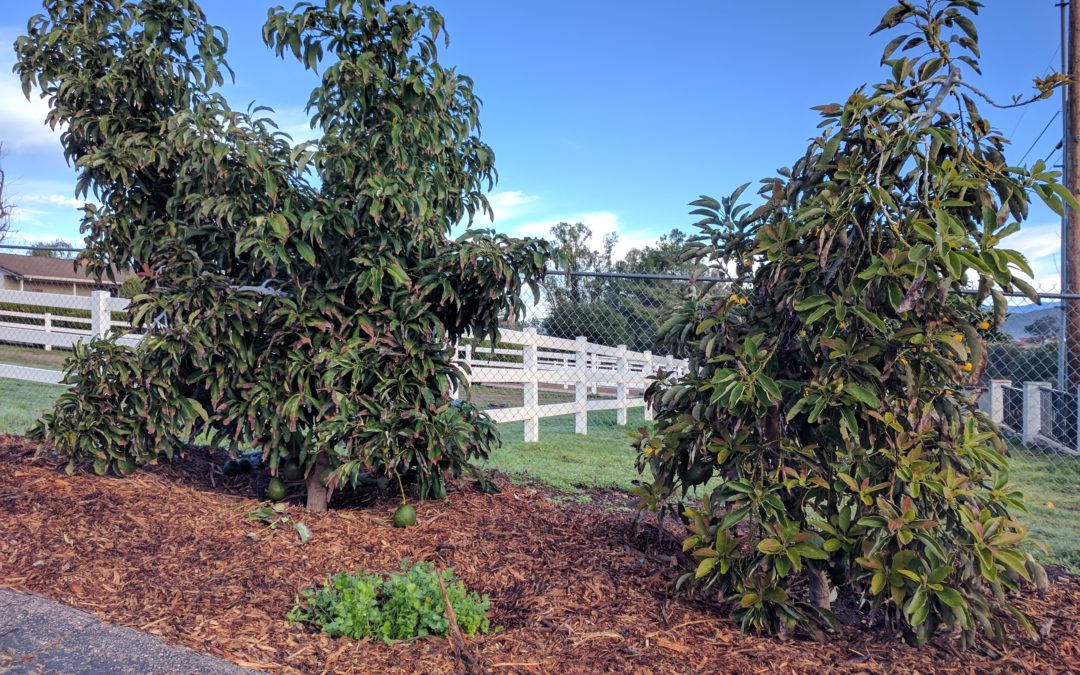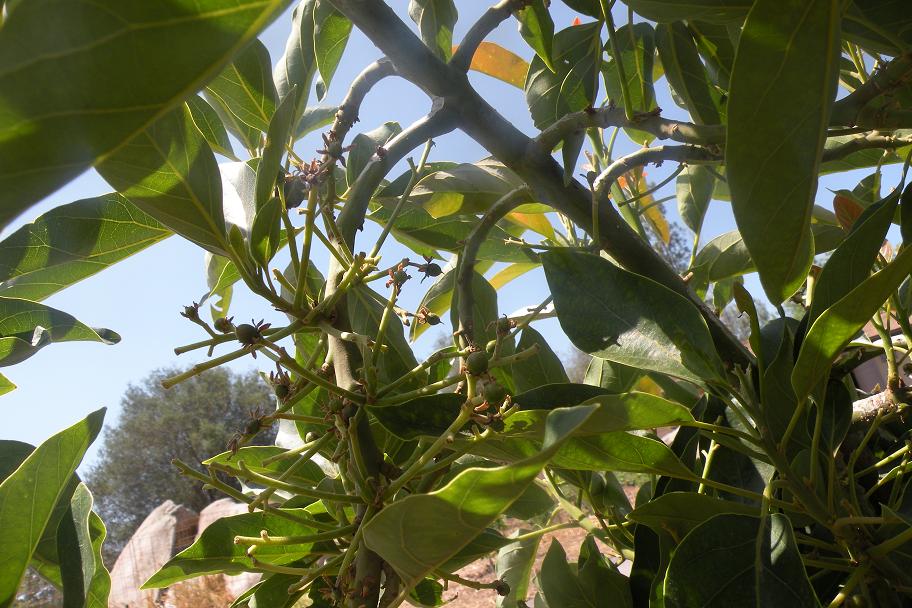No, you don’t need two avocado trees to get fruit. Before I explain how I know this, let me say where I think this myth originates: avocado flowers are strange.
They are dichogamous, it’s called by botanists. The standard description of avocado flower behavior can be found here. Suffice it to say that the conclusion drawn from this standard description is that any single avocado tree has very little opportunity for its flowers to be pollinated, especially in California’s climate, and therefore it’s best to plant two trees of different, complementary flower types in order to get fruit.
But the standard description is oversimplified and this conclusion is mistaken. Rather than get into the complex reality of avocado flower behavior, have a look at the reality that is before my eyes in my yard at this moment:
This is a photo of fruit that has just set on a Lamb avocado tree in my yard.
The only other avocado trees in the yard that flowered this year were a Reed and a Hass. All three of these varieties are “A” types in their flowering behavior. In other words, according to the standard description, they’re not supposed to be able to cross-pollinate because they’re all male at the same time or female at the same time, and are therefore of no use to one another. Moreover, there are no “B” type avocado trees in the yards of my neighbors that could have contributed to this fruitset.
How was my Lamb tree pollinated then? I don’t know for sure. A female flower could’ve received pollen from the male part on the same flower, or from the male part on another flower on the Lamb tree, or it could’ve received pollen from the male part on a flower on the Reed or Hass. I don’t know. And it doesn’t really matter. What I do know from the evidence of the fruit hanging on their limbs is that you certainly don’t need avocado trees of different flower types to get fruit.
There is another question of whether you’ll get more fruit if you have an “A” and a “B” type in proximity. But that’s another question. If you’re interested in reading about that issue, then read my post called “Cross pollination of avocados, or why I planted a Hass next to a Fuerte.”
I’ve seen so many single avocado trees in different parts of Southern California bearing plenty of fruit over the years, but let me note the fruitset on a couple of single trees in my own yard over the last couple years. The Lamb in the photo above held around 40 avocados for eating in 2016. The Reed held about 35, and the Hass held 73. Again, I’ll call these “single” trees because they had no “B” flower-type avocado trees nearby to pollenize them.
UPDATE:
It is now August, 2017, and the Lamb tree has no fruit. Zero. It didn’t flower this year, unfortunately. So that’s not a pollenization issue; it’s a flowering issue, or what is called “alternate bearing.” On the other hand, fortunately, the Reed has 126 fruits, and the Hass has 154. Again, I consider these “single” trees because they have no “B” flower-type avocados nearby. Note that these are the Reed and Hass varieties, and some other varieties don’t bear as well when they are single trees.
You might also like to read:





Is Texas a good place to plan avocado trees?What kind of soil?
Hi Jesse,
It greatly depends on which part of Texas. Unless you’re way down south you’ll have issues with cold damage in winter.
The basic need of avocados is soil that drains well. A place that puddles during and after a rain is dangerous.
Hi Greg, I planted a Haas seed in my backyard in Panama at least 5 years ago and I have never seen a flower on that tree. Needless to say, I have never received a fruit either. How can I get it to flower? I never printed nor grafted it. The tree is at least 20 feet high. I would love to beat fruit. Any advice?
Hi Susan,
Seedling avocado trees often take more than five years to fruit, so don’t be dismayed. One technique that has proven to induce them to fruit earlier is girdling. Basically, that is partially cutting into a branch.
Here are some articles with more information on girdling, and especially girdling seedlings: http://www.avocadosource.com/Journals/HortScience/HortSci_1986_21_PG_1038-1039.pdf
http://www.avocadosource.com/CAS_Yearbooks/CAS_57_1973/CAS_1973-74_PG_058-068.pdf
Best of luck!
So what are the reasons why a heathy avocado tree is not producing fruit?
Hi Marian,
Do you have a specific tree in mind? Is it a seedling or grafted? How old is it?
Hi Suzan
my next door neighbour planted his from a fruit he ate, some 25/30 years ago. It’s now grown to a tall 20 foot tree. Only last year, had it its first fruit (Hass); only about 20 fruits. I do knot see any other avocado tree in the immediate neighbourhood. But I’ve read somewhere that, if you plant your tree from a seed, it takes a minimum of 13 to 15 years before it can have its first fruits.
This march 2024, I just see only 2 (two) new fruits sprouting on that tree.
There is an ENORMOUS avocado tree in my town (like 50 feet tall and maybe 60-70 feet wide), and it has never beared fruit. I suspect that it’s a Hass. No other avocados anywhere near it.
Hi Susan,
This is interesting and timely for me. I’ve been thinking about writing a post on why an avocado tree might have no fruit — in one particular year or never ever. There are many reasons.
In the case of an old tree that has never borne fruit, I’ve heard of seedling (non-grafted) avocado trees that do this although I’ve never seen one myself. All seedling trees I know have fruited at some point — even ones that have no other avocado trees nearby.
I just purchased two trees one is a Joey and the other is a Lila. Do they need to be planted close together or can I plant them in separate places in my yard and have them bear fruit?
Hi Hannah,
I’m guessing you’re in Texas? And you bought a Joey and a Lula? I don’t know how avocado flowers behave in Texas firsthand, but from what I’ve read they behave as they do here in California. For you, this means that if the trees are planted very close to each other they’ll cross-pollenize better, but that’s not necessary in order to bear fruit. Lone avocado trees can bear fruit.
Even if two trees are 50 feet apart, bees are likely to visit both trees somewhat and you’ll have slightly enhanced pollination.
How close do the trees need to be planted to benefit from cross pollination? I am planning on putting one tree in front of the house for shade and two in the back. I can’t decide which varieties to put in which location
I am growing a reed and want to add either Fuerte, sharwil or Jan Boyce if I can locate one..
Hi Nancy,
I’d use the Reed as the lone tree out of those varieties because it fruits very well without another variety nearby.
There will be cross-pollination between all of your trees though. One study comes to mind where it was found that Hass trees were pollenized by Bacon trees that were 250 feet away. (http://www.avocadosource.com/CAS_Yearbooks/CAS_70_1986/CAS_1986_PG_091_098.pdf)
However, the closer together the trees are, the more cross-pollination there will be. If the branches are touching, that’s optimal. It’s certainly not necessary though.
Any two varieties together will enhance one another’s fruitfulness, but if they are different flower types it’s even better. Jan Boyce is an A type, but Fuerte and Sharwil are both B types. (Reed is an A.) Making A/B combinations is ideal for cross-pollination.
I did write a post about this a while back that you might enjoy: https://gregalder.com/yardposts/cross-pollination-of-avocados-or-why-i-planted-a-hass-next-to-a-fuerte/
I have a large single avocado tree in my yard that bears fruit every year, but have a hard time
keeping the fruit on the tree. They are falling off before getting ripe. You can shake the fruit and feel the seed rattle inside. Please reply on what I can do to harvest eatable fruit.
Thanks,
Hi Bob,
Do you know which variety of avocado it is? If not, please send a photo of the fruit and the tree.
I have an odd one… our tree is at least 50 years old. Never bore fruit. This past year it had at least 50 avocados. Maybe it is just shy…
Hi Richard,
Wow! It took 50 years to bear?! That’s incredible. Had it flowered in years past?
Avocados don’t ripen on the tree. When they fall is because they’ve reached their welcome time on the tree and you will have to ripen them inside the h.
30 years ago l planted a Hass.
My neighbor had an Avocado producing few friut rarely and was delighted to get big crops after l planted my tree.
We both were very happy.
Neighbor moved and their Avocado tree suffered and eventually died.
I no longer get avocados.
I got just one this year.
Hello just planted a Fuerte, Type B, and looking to plant a second tree just to give a better chance of fruiting. I have a smaller area for a second tree and looking at the Holiday. This Holiday tree has a different fruiting period? Am I safe to plant Fuerte Alone or so you know if the Holiday tree would help? Hass is option but would need to kelp small.
Hi Joe,
A good companion for Fuerte would have a different harvest season in addition to having an A-type flowering schedule. The following varieties fit those criteria: Hass, GEM, Gwen, Reed, Lamb, and Holiday, among others. The downside of Holiday is that it’s not as productive as those other varieties. Personally, I would rather choose one of the other varieties and prune to keep the tree small. Have you seen this post? https://gregalder.com/yardposts/can-you-grow-an-avocado-tree-in-a-small-yard-space/
Fuerte trees can certainly produce well alone, but it’s very hard to predict whether they will. It depends on the tree and the location.
Thank you Greg great advice and wonderful article you shared. I will see what other Type As are available locally to compliment the Fuerte.
I live in Louisiana. I am planning on planting a Joey and Lila. I hear good things about the ability to grow them here.
How is their flavor? How long of a harvest season do they have?
Hi Andy,
Sorry, but I have no experience with those varieties. They aren’t grown in California. Ask around at Tropical Fruit Forum, where many Texas and Florida growers can give you their experiences.
Im sittin under a huge avocado tree in California that produces fruit every year
Can you grow an avocado tree in a large pot?
Hi Genie,
Yes, you can. I’ve seen many avocado trees in pots with fruit on them up to about 12 feet tall.
The info I have found says most avocado types are self-pollinating but just fruit more with another tree nearby. However, the variety I would like most to get is the Carmen. And everything I have found so far says this tree is not self-pollinating and won’t set fruit without a type-B. What are your thoughts on this? Have you ever had this type of tree?